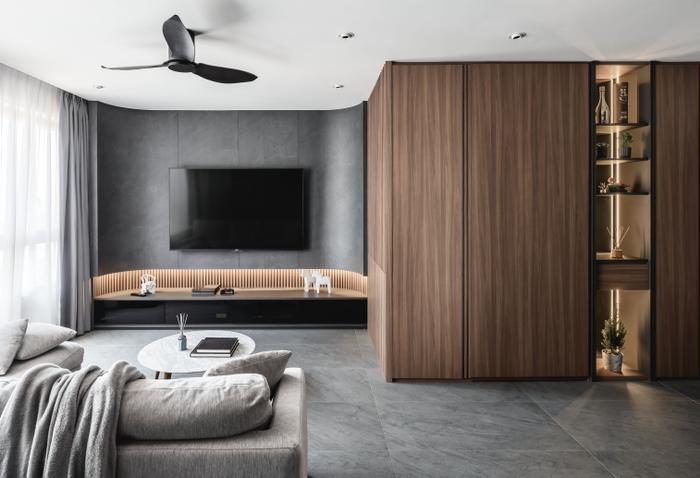All the essentials you need to know.
It has been a long journey towards your dream home – and it's about to get even longer. If the mountains of paperwork done for your HDB purchase and loan application weren’t enough hassle… say hello to renovation permits!
An inescapable reality, HDB has permits for everything under the sun, which have to be approved before your renovations can start proper. But what are they, and which will you need to apply for before renovation can start?
Save yourself the trouble of researching (because life is already tough as it is); here's a list of permits and guidelines for various renovation works that require HDB's blessing (AKA approval).
Works that require HDB permits
For floors:

View this project by Starry Homestead
1. Replacing existing floor tiles
Any flooring materials that require taking out an existing flooring (instead of laying on top) will need approval from HDB. In particular, floor finishes made of marble, stone, ceramic, terrazzo, parquet or other tiles. Guidelines do apply too: for example, the total thickness of these floor finishes cannot exceed 50 mm, among other lengthier rules.
For new flats, take note that alterations and replacement of floor tiles at wet areas – the bathrooms, kitchen, yard, planter box and balcony – within the first three years is not allowed due to the waterproofing system. This comes with a 5-year warranty that will be voided if there are any modifications.

View this project by Weiken.com
2. Topping up flooring in your kitchen, bathroom and balcony
A permit is also required if you plan to (slightly) raise your floors in wet areas like the kitchen, bathroom and balcony. Note that by raising your floors, the height between the finished floor level and windows cannot be less than 1000 mm (100cm).
For walls

View this project by 9 Creation
3. Replacing feature walls
Building up a statement wall from scratch is easy; replacing one that’s already there is not. Before you tear that gaudy wallpaper off, you'll need approval from HDB. And when you're laying on your new, snazzy wall finish, keep in mind that its total thickness cannot be more than 25 mm (2.5 cm).

View this project by Free Space Intent
4. Hacking walls (full and partial)
A bright and airy open-plan space is all the rage these days, but just like a game of Jenga, taking every pillar down will affect your flat’s structure – and is therefore not allowed.

View this project by Visionary Interior
With our floor plan guide, you can find out which structural walls can (or cannot) be hacked. You can, of course, demolish any non-structural walls – but only after your space is evaluated and approved. Note too, that the workers will have to start demolitions from the ceiling down.

View this project by Concrid Interior
5. Archways
Like a little more curves to your shapely flat? While it sounds like a relatively minor addition, HDB thinks otherwise. Like other wall treatments and works, curved arches are subject to approval after HDB evaluates your space.
For doors

View this project by U-Home Interior Design
6. Changing the position of doors
Moving a door's location from one place to another is hefty work (think of the hacking and making good you'd have to do!); that's why HDB has to give the green light to make sure you won't be unnecessarily demolishing any structural pillars. Keep in mind that in particular, doors cannot be created through reinforced concrete walls.
For staircases

View this project by Zenith Arc
7. Replacing railings and installing safety barriers on stairs
Hate the pre-built, slightly outdated HDB railings in your new space? Remember, if you want to switch out your rails with something more sleek, you would have to seek not just HDB, but BCA for a permit to carry out structural works.

View this project by 360 Interior
You will also have to engage a Professional Engineer (PE) to draw up a design and submit for approval. Once BCA gives the green light, you must then submit the approved drawing and permit for HDB to issue another permit. Phew!
For windows

View this project by Flo Design
8. Installing/replacing windows at parapet (windows facing out)
While you can install or change your internal windows (except for full length windows), you would need to follow these strict guidelines after successfully applying for your permit.
For instance, window colour, size and type (sliding or casement) have to be similar to the original HDB windows. There are also size restrictions; casement windows are only allowed a width of 500mm to 700mm, while for sliding windows, it's 500mm to 1200mm.

View this project by Molecule Interior
9. Installing/replacing grilles on service yard/balcony
Grille designs must be HDB-approved, and must follow the appointed designs for your flat, which you can find out in the renovation factsheet provided when collecting your keys or booking your apartment. You can check the specific guidelines for your flat by logging into the MyHDBPage as well.
For bathrooms

View this project by Editor Interior
10. Bathroom area extensions
Need more walking space in your tiny bathroom? Here’s a slight reprieve: homeowners can apply for a permit to expand their bathroom, albeit by a bit – 0.6 sqm, to be exact. Do be aware that this extra space can only be used as a dry area (which means only sinks or shelves). Also, any adjacent gas pipes cannot be enclosed with the extended bath area.

View this project by Design 4 Space
11. Replacement of bathroom floors and walls
As mentioned, for new HDB flats in particular, floor finishes in wet areas cannot be hacked or replaced in the first three years – and for bathrooms, this applies to the walls as well.
This is to make sure that the waterproofing membrane put in place can stabilise and prevent water leakage. (If you'd still like to change up your bathroom, you can go for stick on tiles instead.)

View this project by Attic Studio Interiors
After three years, however, you will be allowed to change your floor or wall tiling, with the approval of an HDB permit. They also come with a set of guidelines; the total thickness of floor finishes/screed should not exceed 50mm (5 cm), while for walls, no tampering of existing structures can be made, and the thickness of finishes cannot exceed 25mm (2.5 cm).
For recess areas

View this project by The Alchemists Design
For older resale flats (any flat built before 1996, and are not DBSS flats), homeowners can actually purchase a small area along the corridor outside their home! Also known as the recess area, this feature however comes with many conditions and guidelines, as building upon the space can affect your neighbours, piping and general safety.

View this project by Aart Boxx Interior
12. Any renovation works within recess area
That includes installing any grilles, doors, windows, awnings, additional non-load bearing walls and your floor and wall finishes. Homeowners will need to apply for a permit, which is subject to approval after evaluation.
Other things about permits you’ll need to know

View this project by Cozy Ideas
1. Permits have time limits
Nothing lasts forever – and neither does the permit. Once your permit is successful, you will need to finish the approved work by three months for new flats, or a month for existing properties like resales.
2. Some popular home features don't require a permit
Turns out, you can have your cake and eat it too. Thankfully, you won’t need an official permit for these popular features, though there are guidelines you’ll need to follow.

View this project by Third Paragraph
- Freestanding/built-in bathtubs: its weight alone cannot be more than 150 kg (which may affect the structural integrity of the space). It has to be placed above a void floor, and flooring cannot be raised or reduced to fit the bathtub.

View this project by The Local INN.terior 新家室
- Living and bed platforms: first off, your home’s ceiling height has to be at least 2.4m. The space between the platform and floor cannot be filled up with cement, and there has to be at least a height of one meter from the top of the platform to the window, for safety reasons (anything less will require a fixed window grille to be installed). No storage is allowed either in the void between the platform and the floor.
*For more information and full guidelines, visit HDB's building works page here.
You don't have to struggle with permits alone.
An experienced interior designer will be able to guide you through the treacherous waters of paperwork - all for creating your ultimate home! Request a free quote here, and we will match you up with up to 5 interior firms, based on your budget and style.
What’s more, you will also be eligible for the Qanvast Trust Programme, which includes the Qanvast Guarantee that safeguards your deposits.
This article was originally published on 18 May 2017 and last updated on 22 February 2023.

 Get a budget estimate before meeting IDs
Get a budget estimate before meeting IDs